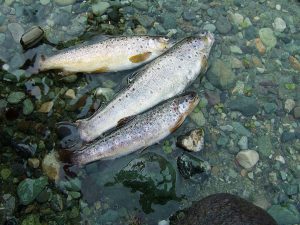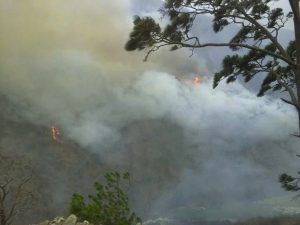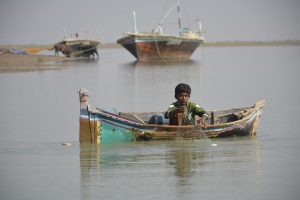In the chilly mountains of Hunacabamba, northern Peru, heated discussion about a Chinese-funded mining project encapsulates the mood as the republic sets about choosing its next president. In this remote area near the border with Ecuador, surrounded by vast and mysterious moorlands, rural communities stand in opposition to the Rio Blanco Copper mining operation, owned by China’s Zijin Mining Group. Each time a presidential candidate visits the region and the community asks about the project, they promise to improve dialogue.
Peru’s recent economic boom is associated with huge investment in mining, led by Chinese. The Rio Blanco project in the province Piura is the site of just one of 145 recorded socio-environmental conflicts in Peru that the next president will have to address, with the added complication of an economic deceleration. At least five major projects are stagnant, with many left wondering what the future holds.
On Sunday, Peruvians will select two of the 10 presidential candidates to face each other in a run-off on June 5. The favourites are Keiko Fujimori from Fuerza Popular (Popular Force), who currently heads the polls with around 33% of voting intentions, Pedro Pablo Kuczynski of Peruanos por el Kambio (Peruvians for Change) with 16%, and Veronika Mendoza of the Frente Amplio (Broad Front) with 15%. In fourth and fifth place respectively, with less than 10%, are Alfredo Barnecha of Acción Popular (Popular Action) and former president Alan Garcia from APRA (American Popular Revolutionary Alliance). Outgoing president Ollanta Humala’s Partido Nacionalista Peruana (Peruvian Nationalist Party or PNP) is not fielding a candidate due to the low level of voting intentions it represents. Peruvian presidencies are constitutionally limited to one five-year term.
Analsysts agree that the eventful campaign – in which the National Jury of Elections excluded two candidates who were initially competing with Fujimori and which has seen a further seven candidates clock up less than 10% – will inevitably go to a second round.
China is Peru’s main foreign investor, with US$19 billion invested in the country, some 34% of all foreign investment. The US accounts for second highest amount with US$10 billion followed by Canada with US$8 billion.
Voters in conflict
Keiko Fujimori, the daughter of ex-president Alberto Fujimori who is currently serving a 25-year sentence for corruption and human rights violations, has switched to a more conciliatory tone on the subject of mining conflicts in recent months.
During her unsuccessful 2011 campaign, Fujimori argued for a form of development based on mining investment. This time around she has spoken of the need to engage in dialogue with affected communities and to properly implement a process of prior consultation with indigenous people.
In the case of the Rio Blanco mine and other paralysed projects, Fujimori has said that she will look to establish a permanent mechanism for dialogue to avoid future conflicts and “achieve a healthy co-existence between mining and agriculture”.
Kuczynski has adopted a similar posture: “There are people that don’t like mining. There will always be someone who doesn’t want a quarry next to their house and that’s understandable. Mining produces jobs and money but it should be clean. No dust and no smoke,” he recently told a local radio station.
However, the candidate who has capitalised most on the discontent surrounding Peru’s mining drive is Mendoza from Frente Amplio, a coalition of leftist organisations, which has seen a surge in voting intentions in the past few weeks and could now see the congresswoman from Cuzco contesting the second round.
Mendoza has severely questioned environmental practices in the mining sector and on visiting places like Rio Blanco and Las Bambas, which is owned by MMG, a subsidiary of China Minmetals Corp., Guoxin Investment Corp International, indicated that these projects would only advance if they received popular approval.
Environmental footprint
Latin America is the destination of the second highest amount of China’s overseas investment after Asia. Much of this investment has focused on extractive industries. However, the slowdown in the Chinese economy paints an uncertain picture.
Official figures indicate that China will continue to be the main investor in Peru in the coming years. Asked by Diálogo Chino about commercial relations between the two countries, José de Echave, from Frente Amplio’s technical team, said that despite problems and falling prices, cooperation would remain strong.
“We’re talking about a principal actor, which is fundamentally different to North American, Australian or European companies,” Echave said, adding; “Chinese companies have financial autonomy and a massive investment fund which allows them to keep buying up projects and acquiring consortia in adverse circumstances.”
Rapid growth in China brought about a boom in Latin American raw material exports, but at the same time had a big role in environmental degradation and social conflicts in the region, according to a study by Boston University’s Global Economic Governance Initiative and Peru’s Universidad del Pacífico, released last year.
Echave recognises that Chinese investment has a big environmental footprint and contributes to the idea that it doesn’t have strong social and environmental standards. However, the former vice-minister for the environment believes that Chinese investors act like any other: “They will try to abide by the country’s social and environmental laws. Our task is to strengthen industrial and environmental standards so that new operators perform in an acceptable way.”
APRA’s Enrique Cornejo, believes China is learning and improving: “Sometimes they don’t comply with environmental standards, but this will change,” he said.
The prospects
Fuerza Popular’s technical team did not respond to questions about how the party sees the relationship with China if Fujimori is elected, but she has perhaps the closest ties with Asian country. Fujimori has met many times with Chinese Communist Party officials, the last time being in July last year.
“Chinese investments dominate the extractive sector and they have more than just a medium and long-term vision,” Echave said, adding; “China is thinking about the next 30 or 40 years. As opposed to US counterparts, Chinese investors follow a more strategic logic.”
The majority of Chinese investments and projects are located in the Andes: Proyecto Galeano, adjacent to the controversial Conga project (in Yanacocha province), Toromocho (Junín), Las Bambas (Apurimac), Pampa de Pongo (Arequipa), Don Javier (Arequipa) and Rio Blanco (Piura). Investment in these projects is expected to reach US$1.5 billion.
“Peru already has an very powerful instrument of cooperation and association with China and it’s not making the most of it. What the US was 30 years ago, China is today – Peru’s main trading partner,” Cornejo said, whilst also pointing to fishing and energy projects. “You have to say that there’s a possibility this presence could be really interesting in other strategic sectors like petrochemicals, for example, which means energy development, and this is an accessible type of business for the Chinese,” he added.
Another of the themes mentioned by Cornejo relates to the challenges posed by the growing trade relationship. “There are some quite complicated issues because of the sheer size of China, which makes competition a bit unequal. Peruvian textiles have suffered a lot because of imports that have been ‘dumped’ by China,” he said.
Primary material dependence
To mine or not to mine? That is the question presidential candidates have to answer. Frente Amplio says that 70% of conflicts are not about the wholesale rejection of mining, but rather conflicts about co-existence. “Yes, 30% [of conflicts] relate to the rejection of projects. But no one is saying that we should stop mining. We are concerned about the extractivist model which mining is a central pillar of. But with a good framework for protecting the rights of affected populations,” Echave said.
Alan García’s Alianza Popular has been the main critic of Frente Amplio’s proposals on mining investment.
Cornejo has criticised Mendoza’s party for “thinking that mining is bad and that it should be replaced with agriculture”. According to Cornejo there are many countries in the world that have both quality mining and agriculture. “You have to be smart and look at what other countries, such as Canada, have done. You can do many things before getting involved in a conflict and it’s the state that has to do something about it, not a third party, NGOs or the private company itself,” he said.
Another bone of contention is the implementation of the process of prior consultation. Presidential candidates mention this in their plans, albeit with varying emphasis. Both Fujimori and Kuczynski have suggested that this tool – which seeks dialogue between the state and indigenous communities – should be deployed in areas affected by industrial exploitation prior to beginning operations. Mendoza, meanwhile, sustains that consultation should be undertaken with all indigenous communities.
The three leading candidates have strongly criticised how the current government has dealt with social conflicts, many of which are associated with the weakening of environmental regulations. All have promised to strengthen the organisms responsible for controlling and regulating extractive industries.
Just days before the elections and with a place in the second round hotly disputed between Mendoza and Kuczynski, this topic is highly visible on Peru’s political landscape.






![Hilsa fish at a market in Barisal, Bangladesh [image by Finn Thilsted]](https://dialogue.earth/content/uploads/2016/04/Hilsa-fish-bangladesh-pic-300x199.jpg)